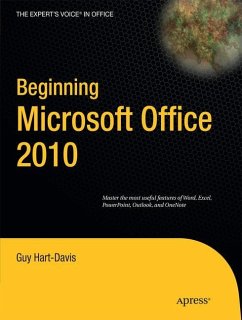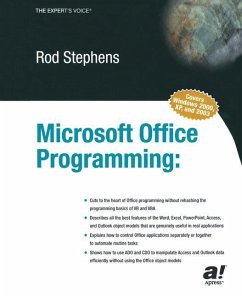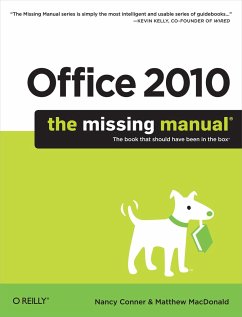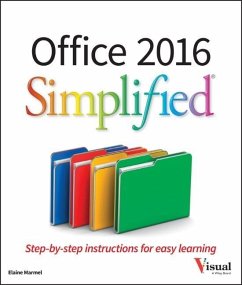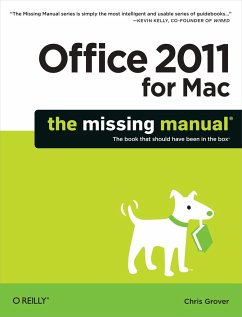Nicht lieferbar
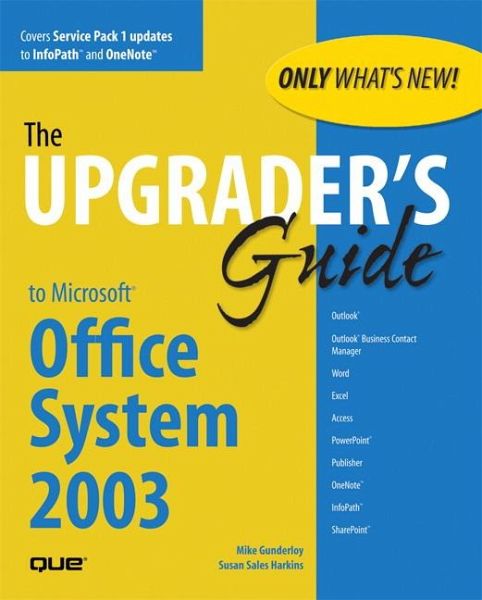
Upgrader's Guide to Microsoft Office System 2003
Versandkostenfrei!
Nicht lieferbar
The only book that covers just the new features of Office 2003 -- For upgraders only!
Quickly find the information you need to maximize your productivity.
Unveils the new, revised, moved, and improved features in Office 2003 Professional.
Includes only relevant content for those upgrading to Office 2003 - no fluff, no extra stuff.
Enables upgraders to quickly learn the new version.
Microsoft Office 2003 is the sixth version of Microsoft's best-selling Office suite. As such, most of the audience is comprised of people who have used previous versions of Office and are quite familiar with most of the features. Upgraders do not need a 800-page book that covers every aspect of every Office application. They need a book that's focused only on what's new, so that they can move forward with a minimum of fuss. That's what this book is all about. This book covers Microsoft Office 2003, Professional Edition. It provides coverage of not just new features, but features that have been improved, revised, or just moved around. Those users frustrated by moved features will find useful callouts to indicate where to find those features, as well as point out potential pitfalls for those used to the old way of doing things. The Upgrader's Guide includes information on overall Office changes and chapters on each individual application. As a bonus, information on the newest members of the Office family: OneNote, InfoPath, and Digital Rights Management are included. The Upgrader's guide has two potential audiences. Users who have already upgraded and want to maximize their productivity and users determining whether to upgrade to Office 2003. Microsoft has pre-sold a number of licenses under their "Software Assurance" program; every one of those licenses represents a potential user. Mike Gunderloy has been working with Microsoft Office ever since the very first version, Office 4.3, was released for Windows 3.1. An early beta tester of Office 2003 and contributor to many books and articles on Office topics, he's well-qualified to show you what's changed. Susan Sales Harkins has been writing about Office applications from the beginning and still makes Office her primary expertise.
Product Description
Microsoft Office 2003 is the sixth version of Microsoft's best-selling Office suite. As such, most of the audience is comprised of people who have used previous versions of Office and are quite familiar with most of the features. Upgraders do not need a 800-page book that covers every aspect of every Office application. They need a book that's focused only on what's new, so that they can move forward with a minimum of fuss. That's what this book is all about.
Introduction.
1. What's New in Office 2003.
The Office System.
Collaboration.
XML.
XML Support in Word, Excel, and Access.
InfoPath.
Rights Management.
Servers, Services, and Solutions.
2. Shared Office Features.
Touring the New Look and Feel of Office.
Icons, Menus, and Toolbars.
Customizing the User Interface.
Tapping into Task Panes.
Using the New Office Help System.
The Help Menu.
The Help Task Pane.
Working with the Research Task Pane.
Understanding Document and Meeting Workspaces.
Using Document Workspaces.
Using Meeting Workspaces.
3. What's New in Outlook 2003.
New Look and Feel.
The New Menus.
Three Panes-Lots of Options!
Quick Access to Favorite Folders.
Using Outlook As a Personal Information Manager.
Quick Flags for Recognition.
Search Folders Create Unique Views.
Intelligent Grouping.
Picturing Your Contacts.
Email Management Features.
Improved AutoComplete.
Intuitive Arrangements.
Dynamic Distribution Lists.
Filtering Junk Email.
Multiple Signatures.
Attachment Freedom-Sort of..
Rules Rule!
Productivity Enhancements.
More Storage Room.
Exchange Server 2003 and SharePoint Integration.
Working Offline Using Cached Exchange Mode.
Let Me Check Your Calendar.
Corporate-Level Filtering.
Managing SharePoint Alerts.
Planning Meetings.
Business Contact Manager.
For the Developer.
4. What's New in Word 2003.
User Interface Changes.
Menu Changes.
The New Task Panes.
Reading Layout.
Compare Side by Side.
Using Word As an XML Editor.
Editing an XML Document.
XML Schema Support.
Using XSL Transformations.
Understanding WordProcessingML.
Other New Features.
5. What's New in Excel 2003.
Changes to the User Interface.
The New Menus.
New Look and Feel.
The New Workbook Task Pane.
Side-by-Side Workbooks.
Extensible Markup Language Support.
What's XML?
Opening an XML File.
Importing XML into an Excel List.
Adding an XML Map to a Workbook.
About Repeating XML Elements.
More About the XML Source Task Pane.
About SpreadsheetML.
Productivity.
Document Recovery.
Excel Lists.
Creating an Excel List.
Working with Excel Lists.
Collaboration Improvements.
List Integration with SharePoint.
6. What's New in PowerPoint 2003.
Changes to the User Interface.
The New Menus.
New Look and Feel.
Productivity Enhancements.
Downloading New Templates.
Using Ink to Mark a Presentation.
Smart Tags.
Packaging a Presentation and PowerPoint Viewer.
Packaging a Presentation.
Using the PowerPoint Viewer.
Multimedia Support.
Supported Media Formats.
New Online Broadcasting Options.
Full-Screen Playback.
7. What's New in Access 2003.
Changes to the User Interface.
The New Menus.
The New Task Panes.
Productivity.
Viewing Object Dependencies.
Smart Tags.
Automatic Backup.
Local Linked Tables.
Sorting Control Lists.
New Service Options.
Enhanced XML Support.
Exporting and Importing Relationships.
Applying Transforms.
Changes to Security.
SharePoint Integration.
Exporting a Table or Query to a SharePoint List.
Importing SharePoint Data into Access.
8. What's New in FrontPage 2003.
Changes to the User Interface.
The New Menus.
The New Task Panes.
Two New Views.
Two New Toolbars.
Introducing Scripting Behaviors.
Better Design and Graphic Tools.
Layout Tables and Cells.
Interactive Buttons.
Dynamic Web Templates.
Browser and Resolution Reconciliation.
Accessibility Checking.
Other Layout Tools.
Working with Code.
Quick Tag Selector and Editor.
Optimizing HTML.
Other New Coding Perks.
SharePoint Services Integration.
Data Source View and Web Parts.
Web Package Templates.
9. What's New in Publisher 2003.
Changes to the User Interface.
&nb
Quickly find the information you need to maximize your productivity.
Unveils the new, revised, moved, and improved features in Office 2003 Professional.
Includes only relevant content for those upgrading to Office 2003 - no fluff, no extra stuff.
Enables upgraders to quickly learn the new version.
Microsoft Office 2003 is the sixth version of Microsoft's best-selling Office suite. As such, most of the audience is comprised of people who have used previous versions of Office and are quite familiar with most of the features. Upgraders do not need a 800-page book that covers every aspect of every Office application. They need a book that's focused only on what's new, so that they can move forward with a minimum of fuss. That's what this book is all about. This book covers Microsoft Office 2003, Professional Edition. It provides coverage of not just new features, but features that have been improved, revised, or just moved around. Those users frustrated by moved features will find useful callouts to indicate where to find those features, as well as point out potential pitfalls for those used to the old way of doing things. The Upgrader's Guide includes information on overall Office changes and chapters on each individual application. As a bonus, information on the newest members of the Office family: OneNote, InfoPath, and Digital Rights Management are included. The Upgrader's guide has two potential audiences. Users who have already upgraded and want to maximize their productivity and users determining whether to upgrade to Office 2003. Microsoft has pre-sold a number of licenses under their "Software Assurance" program; every one of those licenses represents a potential user. Mike Gunderloy has been working with Microsoft Office ever since the very first version, Office 4.3, was released for Windows 3.1. An early beta tester of Office 2003 and contributor to many books and articles on Office topics, he's well-qualified to show you what's changed. Susan Sales Harkins has been writing about Office applications from the beginning and still makes Office her primary expertise.
Product Description
Microsoft Office 2003 is the sixth version of Microsoft's best-selling Office suite. As such, most of the audience is comprised of people who have used previous versions of Office and are quite familiar with most of the features. Upgraders do not need a 800-page book that covers every aspect of every Office application. They need a book that's focused only on what's new, so that they can move forward with a minimum of fuss. That's what this book is all about.
Introduction.
1. What's New in Office 2003.
The Office System.
Collaboration.
XML.
XML Support in Word, Excel, and Access.
InfoPath.
Rights Management.
Servers, Services, and Solutions.
2. Shared Office Features.
Touring the New Look and Feel of Office.
Icons, Menus, and Toolbars.
Customizing the User Interface.
Tapping into Task Panes.
Using the New Office Help System.
The Help Menu.
The Help Task Pane.
Working with the Research Task Pane.
Understanding Document and Meeting Workspaces.
Using Document Workspaces.
Using Meeting Workspaces.
3. What's New in Outlook 2003.
New Look and Feel.
The New Menus.
Three Panes-Lots of Options!
Quick Access to Favorite Folders.
Using Outlook As a Personal Information Manager.
Quick Flags for Recognition.
Search Folders Create Unique Views.
Intelligent Grouping.
Picturing Your Contacts.
Email Management Features.
Improved AutoComplete.
Intuitive Arrangements.
Dynamic Distribution Lists.
Filtering Junk Email.
Multiple Signatures.
Attachment Freedom-Sort of..
Rules Rule!
Productivity Enhancements.
More Storage Room.
Exchange Server 2003 and SharePoint Integration.
Working Offline Using Cached Exchange Mode.
Let Me Check Your Calendar.
Corporate-Level Filtering.
Managing SharePoint Alerts.
Planning Meetings.
Business Contact Manager.
For the Developer.
4. What's New in Word 2003.
User Interface Changes.
Menu Changes.
The New Task Panes.
Reading Layout.
Compare Side by Side.
Using Word As an XML Editor.
Editing an XML Document.
XML Schema Support.
Using XSL Transformations.
Understanding WordProcessingML.
Other New Features.
5. What's New in Excel 2003.
Changes to the User Interface.
The New Menus.
New Look and Feel.
The New Workbook Task Pane.
Side-by-Side Workbooks.
Extensible Markup Language Support.
What's XML?
Opening an XML File.
Importing XML into an Excel List.
Adding an XML Map to a Workbook.
About Repeating XML Elements.
More About the XML Source Task Pane.
About SpreadsheetML.
Productivity.
Document Recovery.
Excel Lists.
Creating an Excel List.
Working with Excel Lists.
Collaboration Improvements.
List Integration with SharePoint.
6. What's New in PowerPoint 2003.
Changes to the User Interface.
The New Menus.
New Look and Feel.
Productivity Enhancements.
Downloading New Templates.
Using Ink to Mark a Presentation.
Smart Tags.
Packaging a Presentation and PowerPoint Viewer.
Packaging a Presentation.
Using the PowerPoint Viewer.
Multimedia Support.
Supported Media Formats.
New Online Broadcasting Options.
Full-Screen Playback.
7. What's New in Access 2003.
Changes to the User Interface.
The New Menus.
The New Task Panes.
Productivity.
Viewing Object Dependencies.
Smart Tags.
Automatic Backup.
Local Linked Tables.
Sorting Control Lists.
New Service Options.
Enhanced XML Support.
Exporting and Importing Relationships.
Applying Transforms.
Changes to Security.
SharePoint Integration.
Exporting a Table or Query to a SharePoint List.
Importing SharePoint Data into Access.
8. What's New in FrontPage 2003.
Changes to the User Interface.
The New Menus.
The New Task Panes.
Two New Views.
Two New Toolbars.
Introducing Scripting Behaviors.
Better Design and Graphic Tools.
Layout Tables and Cells.
Interactive Buttons.
Dynamic Web Templates.
Browser and Resolution Reconciliation.
Accessibility Checking.
Other Layout Tools.
Working with Code.
Quick Tag Selector and Editor.
Optimizing HTML.
Other New Coding Perks.
SharePoint Services Integration.
Data Source View and Web Parts.
Web Package Templates.
9. What's New in Publisher 2003.
Changes to the User Interface.
&nb
The only book that covers just the new features of Office 2003 -- For upgraders only! * Quickly find the information you need to maximize your productivity. * Unveils the new, revised, moved, and improved features in Office 2003 Professional. * Includes only relevant content for those upgrading to Office 2003 - no fluff, no extra stuff. * Enables upgraders to quickly learn the new version. Microsoft Office 2003 is the sixth version of Microsoft's best-selling Office suite. As such, most of the audience is comprised of people who have used previous versions of Office and are quite familiar with most of the features. Upgraders do not need a 800-page book that covers every aspect of every Office application. They need a book that's focused only on what's new, so that they can move forward with a minimum of fuss. That's what this book is all about. This book covers Microsoft Office 2003, Professional Edition. It provides coverage of not just new features, but features that have been improved, revised, or just moved around. Those users frustrated by moved features will find useful callouts to indicate where to find those features, as well as point out potential pitfalls for those used to the old way of doing things. The Upgrader's Guide includes information on overall Office changes and chapters on each individual application. As a bonus, information on the newest members of the Office family: OneNote, InfoPath, and Digital Rights Management are included. The Upgrader's guide has two potential audiences. Users who have already upgraded and want to maximize their productivity and users determining whether to upgrade to Office 2003. Microsoft has pre-sold a number of licenses under their "Software Assurance" program; every one of those licenses represents a potential user. Mike Gunderloy has been working with Microsoft Office ever since the very first version, Office 4.3, was released for Windows 3.1. An early beta tester of Office 2003 and contributor to many books and articles on Office topics, he's well-qualified to show you what's changed. Susan Sales Harkins has been writing about Office applications from the beginning and still makes Office her primary expertise.




![New Perspectives on Microsoft Office 2003, First Course [With CDROM] Cover New Perspectives on Microsoft Office 2003, First Course [With CDROM]](https://bilder.buecher.de/produkte/21/21004/21004377n.jpg)

